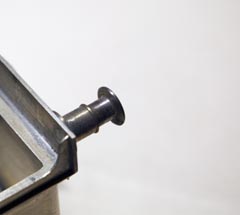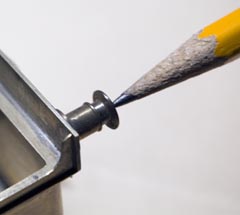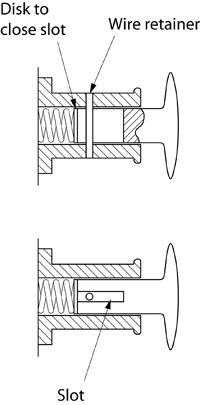


On many prototypes, the back of the buffer beam can be seen. Either it is completely exposed, as frequently happened on early, small or industrial locos, or it is only slightly concealed by a small footplate angle. And if you decide to spring the buffers, which is usually a good idea for operational reasons, the result, all too often, is an unsightly nut at the rear of the beam holding the buffer stem in place. What is needed is a self-contained, sprung buffer. The sketch below shows my solution to the problem, and the photos illustrate a working buffer, just in case you donít believe it can be done.
Cut a slot in the stem of the buffer head. Some measurement is required here. The depth of the slot determines how much the buffer can be depressed, but it must not be so deep that it can be seen when the buffer is fully extended. The tool for the job is a slitting saw held in a lathe or milling machine, so that the buffer stem can be securely clamped and advanced, but with care it can be done by hand with a saw. A disk of thin material is then soldered over the end of the stem to close off the slot, and filed smooth to diameter.
The buffer body is drilled transversely, using a drill slightly smaller than the width of the slot. Again, measure carefully so that the buffer head travels far enough when depressed, but the end of the slot cannot be seen when it is extended. To ensure that the holes on the two sides line up, drill one side, insert the head and align the slot with the hole, and use the slot to guide the drill across the body and drill the other side.
Now solder the body in place on the buffer beam. The buffer beam must of course be solid. If the kit manufacturer has helpfully provided a hole, you will have to make a new beam or fill the hole. A neat rectangular patch on the back of the beam will look like a strengthening plate, and a lot better than the nut you would otherwise be fitting. Now drop the spring into the hole so formed, insert the stem, line up the slot with the transverse holes, and push a length of wire right through to retain it. Solder the wire in place, cut off and clean up, and you are done.
The buffer body is drilled transversely, using a drill slightly smaller than the width of the slot. Again, measure carefully so that the buffer head travels far enough when depressed, but the end of the slot cannot be seen when it is extended. To ensure that the holes on the two sides line up, drill one side, insert the head and align the slot with the hole, and use the slot to guide the drill across the body and drill the other side.
Now solder the body in place on the buffer beam. The buffer beam must of course be solid. If the kit manufacturer has helpfully provided a hole, you will have to make a new beam or fill the hole. A neat rectangular patch on the back of the beam will look like a strengthening plate, and a lot better than the nut you would otherwise be fitting. Now drop the spring into the hole so formed, insert the stem, line up the slot with the transverse holes, and push a length of wire right through to retain it. Solder the wire in place, cut off and clean up, and you are done.
Self-contained buffers

Nick Baines • Model Engineering